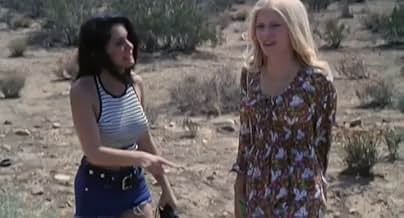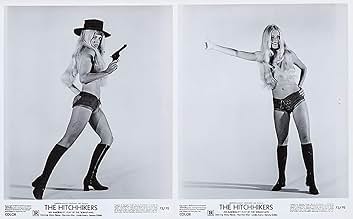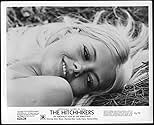Two summers after the Manson Family murders, a nonconformist dude enjoys his own li'l harem in the Southwest desert, but they have to make money somehow and so prey upon men stopping for the alluring girls as they pretend to be hitchhikers.
"The Hitchhikers" (1972) belongs to the counterculture genre that ran from the late 60s to early 70s. While the outlaw biker flicks from that same period were a separate genre, there was some crossover. For instance, there's a biker dude here that visits the hippies in the ghost town. Or take "Angels Hard as They Come" from the year prior, which likewise features nonconformists living in a SoCal ghost town. Thankfully, this is superior.
It only cost $223,200, which would be equal $1.6 million today. By Comparison, "Vanishing Point" from the previous year had 6.5 times as much money with which to work. The best part is the three main females and how their beauty is effectively captured on camera without getting too sleazy (although there's a little tame nudity).
My favorite is the redhead, Karen, whom I'm assuming is Tammy Gibbs (it's hard to tell because the credits ambiguously list three of the girls simply as 'hitchhiker'). Meanwhile blonde Misty Rowe plays protagonist Maggie and brunette Linda Avery plays her rival Diane. All three are physically stunning. But how long can their outward beauty last living in such conditions? What will they look like in a mere ten years?
"Easy Rider" was easily the best of the counterculture flicks, although "Billy Jack" was a worthy Indie contender, whereas "The Wild Angels" was arguably the best of the outlaw biker movies. All three contained great depth beneath the surface entertainment. "The Hitchhikers" is playful fluff by comparison, but works as a snapshot in time of the 'free love' counterculture movement and what happened after their 'peace and love' ideal was destroyed overnight with the 1969 Manson Family murders, followed by the Altamont Free Concert fiasco four months later.
"The Wild Angels," "Easy Rider," "Vanishing Point" and "Dirty Mary Crazy Larry" showed the inevitable consequences of counterculture folly, but this one uniquely keeps a playful spirit. However, you could say that what the group is forced to do in order to make a living is their own perdition, not to mention their primitive, drug-addled living conditions in the ghost town. Down the road, I'm pretty sure they're going to realize that holding up men with guns is evil; it's a form of abuse at least and torture at worst. Maybe they justify their actions on the grounds that their victims were lustful males, but what about the minister, who seemed to stop simply to do a good deed by giving a pedestrian a ride?
The soundtrack is of the Woodstock variety, upbeat folk rock, except by no-names. There's zero hard rock, let alone heavy metal, the latter of which had only existed for about a year when this was made in 1971.
It runs 1 hour, 32 minutes, and was shot in Thousand Oaks, California, which is 35 miles west of Hollywood and 20 miles northwest of Malibu.
GRADE: B-

















